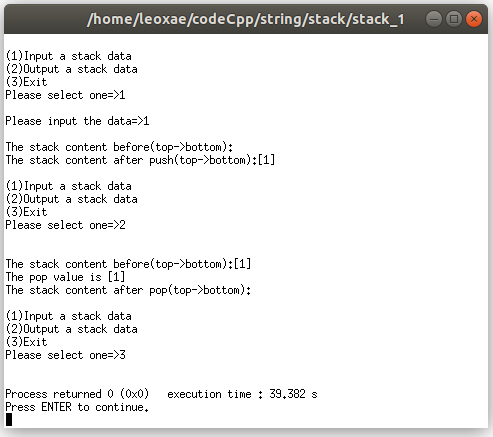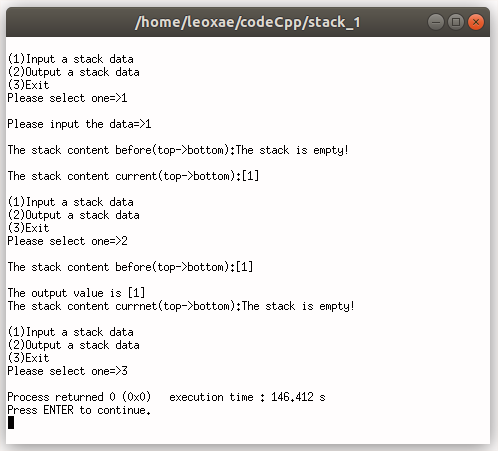[数据结构]栈与队列
目录
1.2 栈和队列
1.2.1 用数组仿真堆栈
#include"stdio.h"
#define MaxSize 10
int stack[MaxSize];
int top=-1;
void push(int value)
{
int i;
if(top>=MaxSize)
printf("\nThe stack is full!\n");
else
{
printf("\nThe stack content before(top->bottom):");
for(i=top;i>=0;i--)
printf("[%d]",stack[i]);
top++;
stack[top]=value;
printf("\nThe stack content after push(top->bottom):");
for(i=top;i>=0;i--)
printf("[%d]",stack[i]);
printf("\n");
}
}
int pop()
{
int temp;
int i;
if(top<0)
{
printf("\nThe stack is empty!\n");
return -1;
}
printf("\nThe stack content before(top->bottom):");
for(i=top;i>=0;i--)
printf("[%d]",stack[i]);
temp=stack[top];
top--;
printf("\nThe pop value is [%d]",temp);
printf("\nThe stack content after pop(top->bottom):");
for(i=top;i>=0;i--)
printf("[%d]",stack[i]);
printf("\n");
return temp;
}
int main()
{
int select;
int stack[5];
int i,value;
printf("\n(1)Input a stack data");
printf("\n(2)Output a stack data");
printf("\n(3)Exit");
printf("\nPlease select one=>");
scanf("%d",&select);
do
{
switch(select)
{
case 1:printf("\nPlease input the data=>");
scanf("%d",&value);
push(value);
break;
case 2:value=pop();
break;
}
printf("\n(1)Input a stack data");
printf("\n(2)Output a stack data");
printf("\n(3)Exit");
printf("\nPlease select one=>");
scanf("%d",&select);
printf("\n");
}while(select!=3);
return 0;
}
运行结果

1.2.2 用链表仿真堆栈
#include <malloc.h>
#include"stdio.h"
struct s_node
{
int data;
struct s_node *next;
};
typedef struct s_node s_list;
typedef s_list *link;
link stack=NULL;
void print_stack()
{
link temp=NULL;
temp=stack;
if(temp==NULL)
printf("The stack is empty!\n");
else
{
while(temp!=NULL)
{
printf("[%d]",temp->data);
temp=temp->next;
}
printf("\n");
}
}
void push(int value)
{
link newnode;
printf("\nThe stack content before(top->bottom):");
print_stack();
newnode=(link)malloc(sizeof(s_list));
newnode->data=value;
newnode->next=stack;
stack=newnode;
}
int pop()
{
link top;
int temp;
printf("\nThe stack content before(top->bottom):");
print_stack();
if(stack!=NULL)
{
top=stack;
stack=stack->next;
temp=top->data;
free(top);
return temp;
}
else
return -1;
}
int main()
{
link point;
int select;
int i,value;
printf("\n(1)Input a stack data");
printf("\n(2)Output a stack data");
printf("\n(3)Exit");
printf("\nPlease select one=>");
scanf("%d",&select);
do
{
switch(select)
{
case 1:printf("\nPlease input the data=>");
scanf("%d",&value);
push(value);
printf("\nThe stack content current(top->bottom):");
print_stack();
break;
case 2:value=pop();
printf("\nThe output value is [%d]",value);
printf("\n");
printf("The stack content currnet(top->bottom):");
print_stack();
break;
}
printf("\n(1)Input a stack data");
printf("\n(2)Output a stack data");
printf("\n(3)Exit");
printf("\nPlease select one=>");
scanf("%d",&select);
}while(select!=3);
return 0;
}
运行结果

1.2.3 顺序栈公用
#include "stdio.h"
#define MEMORY_SIZE 100 /* 内存大小 */
#define MAX_STACKS 10 /* 栈的个数加1*/
typedef char element;
element memory [MEMORY_SIZE];
int top[MAX_STACKS-1];
int boundary[MAX_STACKS];
/* 置栈空*/
void Initial(int n)
{/*将各个顺序栈置空*/
int i;
top [0] = boundary [0] = -1;
for ( i =1; i<n; i ++ )
top[i]=boundary[i]= (MEMORY_SIZE/n)*i;
boundary[n]=MEMORY_SIZE-1;
}
/*进栈*/
void Push(int i, element item)
{
if (top[i] == boundary[i+1] )
{
printf("第%d个栈已满。",i);
}
memory[++top[i]] = item;
}
/*退栈*/
element Pop(int i)
{
if ( top[i] == boundary[i] )
{
printf("第%d个栈已空。",i);
}
return memory[top[i]--];
}
int main()
{
int n=2; /* 使用的栈的个数 */
element first,sec;
Initial(n);
Push(1,'a');
Push(0,'b');
sec=Pop(1);
first=Pop(0);
return 0;
}
1.2.4 进制转换问题
#include "stdio.h"
#include "stdlib.h"
#define StackSize 100 /*假定预分配的栈空间最多为100个元素*/
typedef int DataType;/*假定栈元素的数据类型为字符*/
typedef struct{
DataType data[StackSize];
int top;
}SeqStack;
/* 置栈空*/
void Initial(SeqStack *S)
{/*将顺序栈置空*/
S->top=-1;
}
/*判栈空*/
int IsEmpty(SeqStack *S)
{
return S->top==-1;
}
/*判栈满*/
int IsFull(SeqStack *S)
{
return S->top==StackSize-1;
}
/*进栈*/
void Push(SeqStack *S,DataType x)
{
if (IsFull(S))
{
printf("栈上溢"); /*上溢,退出运行*/
exit(1);
}
S->data[++S->top]=x;/*栈顶指针加1后将x入栈*/
}
/*出栈*/
DataType Pop(SeqStack *S)
{
if(IsEmpty(S))
{
printf("栈为空"); /*下溢,退出运行*/
exit(1);
}
return S->data[S->top--];/*栈顶元素返回后将栈顶指针减1*/
}
/* 取栈顶元素*/
DataType Top(SeqStack *S)
{
if(IsEmpty(S))
{
printf("栈为空"); /*下溢,退出运行*/
exit(1);
}
return S->data[S->top];
}
void MultiBaseOutput (int N,int B)
{/*假设N是非负的十进制整数,输出等值的B进制数*/
int i;
SeqStack S;
Initial(&S);
while(N){ /*从右向左产生B进制的各位数字,并将其进栈*/
Push(&S,N%B); /*将bi进栈0<=i<=j*/
N=N/B;
}
while(!IsEmpty(&S)){ /*栈非空时退栈输出*/
i=Pop(&S);
printf("%d",i);
}
}
int main()
{
MultiBaseOutput(1023,2);
return 0;
}
运行结果

1.2.5 顺序队列操作
#include "stdio.h"
#include "stdlib.h"
#define QueueSize 100 /*假定预分配的队列空间最多为100个元素*/
typedef int DataType;/*假定队列元素的数据类型为字符*/
typedef struct{
DataType data[QueueSize];
int front;/*头指针*/
int rear;/*尾指针*/
}SeqQueue;
/* 置队列空*/
void Initial(SeqQueue *Q)
{/*将顺序队列置空*/
Q->front=Q->rear=0;
}
/*判队列空*/
int IsEmpty(SeqQueue *Q)
{
return Q->front==Q->rear;
}
/*判队列满*/
int IsFull(SeqQueue *Q)
{
return Q->rear==QueueSize-1+Q->front;
}
/*进队列*/
void Push(SeqQueue *Q,DataType x)
{
if (IsFull(Q))
{
printf("队列上溢"); /*上溢,退出运行*/
exit(1);
}
Q->data[Q->rear++]=x;/*队列顶指针加1后将x入队列*/
}
/*出队列*/
DataType Pop(SeqQueue *Q)
{
if(IsEmpty(Q))
{
printf("队列为空"); /*下溢,退出运行*/
exit(1);
}
return Q->data[Q->front++];/*队列顶元素返回后将队列顶指针减1*/
}
/* 取队列顶元素*/
DataType Top(SeqQueue *Q)
{
if(IsEmpty(Q))
{
printf("队列为空"); /*下溢,退出运行*/
exit(1);
}
return Q->data[Q->front];
}
int main()
{
SeqQueue s;
DataType first,sec;
Initial(&s);
Push(&s,'a');
Push(&s,'b');
first=Top(&s);
Pop(&s);
sec=Top(&s);
Pop(&s);
return 0;
}
1.2.6 循环队列
#include "stdio.h"
#include "stdlib.h"
#define QueueSize 100 /*假定预分配的队列空间最多为100个元素*/
typedef int DataType;/*假定队列元素的数据类型为字符*/
typedef struct{
DataType data[QueueSize];
int front;/*头指针*/
int rear;/*尾指针*/
int count; /*计数器,记录队中元素总数*/
}CirQueue;
/* 置队列空*/
void Initial(CirQueue *Q)
{/*将顺序队列置空*/
Q->front=Q->rear=0;
Q->count=0; /*计数器置0*/
}
/* 判队列空*/
int IsEmpty(CirQueue *Q)
{
return Q->front==Q->rear;
}
/*判队列满*/
int IsFull(CirQueue *Q)
{
return Q->rear==QueueSize-1+Q->front;
}
/*进队列*/
void EnQueue(CirQueue *Q,DataType x)
{
if (IsFull(Q))
{
printf("队列上溢"); /*上溢,退出运行*/
exit(1);
}
Q->count ++; /*队列元素个数加1*/
Q->data[Q->rear]=x; /*新元素插入队尾*/
Q->rear=(Q->rear+1)%QueueSize; /*循环意义下将尾指针加1*/
}
/*出队列*/
DataType DeQueue(CirQueue *Q)
{
DataType temp;
if(IsEmpty(Q))
{
printf("队列为空"); /*下溢,退出运行*/
exit(1);
}
temp=Q->data[Q->front];
Q->count--; /*队列元素个数减1*/
Q->front=(Q->front+1)&QueueSize; /*循环意义下的头指针加1*/
return temp;
}
/* 取队列顶元素*/
DataType Front(CirQueue *Q)
{
if(IsEmpty(Q))
{
printf("队列为空"); /*下溢,退出运行*/
exit(1);
}
return Q->data[Q->front];
}
int main()
{
CirQueue s;
DataType first,sec;
Initial(&s);
EnQueue(&s,'a');
EnQueue(&s,'b');
first=Front(&s);
DeQueue(&s);
sec=Front(&s);
DeQueue(&s);
return 0;
}
1.2.7 链队列的入队、出队
#include "stdio.h"
#include "stdlib.h"
#define QueueSize 100 /*假定预分配的队列空间最多为100个元素*/
typedef char DataType ; /*假定队列元素的数据类型为字符*/
typedef struct node{
DataType data;
struct node *next;
}QueueNode;
typedef struct{
QueueNode *front; /*头指针*/
QueueNode *rear;
}LinkQueue;
/* 置队列空*/
void Initial(LinkQueue *Q)
/*将顺序队列置空*/
{ Q->front=Q->rear=NULL;
}
/*判队列空*/
int IsEmpty(LinkQueue *Q)
{
return Q->front==NULL&&Q->rear==NULL;
}
/*进队列*/
void Push(LinkQueue *Q,DataType x)
{
/*将元素x插入链队列尾部*/
QueueNode *p=(QueueNode *)malloc(sizeof(QueueNode));/*申请新结点*/
p->data=x;
p->next=NULL;
if(IsEmpty(Q))
Q->front=Q->rear=p; /*将x插入空队列*/
else
{ /*x插入非空队列的尾*/
Q->rear->next=p; /*p链到原队尾结点后*/
Q->rear=p; /*队尾指针指向新的尾*/
}
}
/*出队列*/
DataType Pop(LinkQueue *Q)
{
DataType x;
QueueNode *p;
if(IsEmpty(Q))
{
printf("队列为空");/*下溢*/
exit(1);
}
p=Q->front; /*指向对头结点*/
x=p->data; /*保存对头结点的数据*/
Q->front=p->next; /*将对头结点从链上摘下*/
if(Q->rear==p)/*原队中只有一个结点,删去后队列变空,此时队头指针已为空*/
Q->rear=NULL;
free(p); /*释放被删队头结点*/
return x; /*返回原队头数据*/
}
/* 取队列顶元素*/
DataType Front(LinkQueue *Q)
{
if(IsEmpty(Q))
{
printf("队列为空"); /*下溢,退出运行*/
exit(1);
}
return Q->front->data;
}
int main()
{
LinkQueue s;
DataType first,sec;
Initial(&s);
Push(&s,'a');
Push(&s,'b');
first=Front(&s);
Pop(&s);
sec=Front(&s);
Pop(&s);
return 0;
}
1.2.8 舞伴问题
#include "stdio.h"
#include "stdlib.h"
#define MAX_DANCERS 100//最多跳舞人数
#define QueueSize 100 //假定预分配的队列空间最多为100个元素
typedef struct{
char name[20];
char sex; //性别,'F'表示女性,'M'表示男性
}Person;
typedef Person DataType; //将队列中元素的数据类型改为Person
typedef struct{
DataType data[QueueSize];
int front;//头指针
int rear;//尾指针
int count; //计数器,记录队中元素总数
}CirQueue;
// 置队列空
void Initial(CirQueue *Q)
{//将顺序队列置空
Q->front=Q->rear=0;
Q->count=0; //计数器置0
}
//判队列空
int IsEmpty(CirQueue *Q)
{
return Q->front==Q->rear;
}
//判队列满
int IsFull(CirQueue *Q)
{
return Q->rear==QueueSize-1+Q->front;
}
//进队列
void EnQueue(CirQueue *Q,DataType x)
{
if (IsFull(Q))
{
printf("队列上溢"); //上溢,退出运行
exit(1);
}
Q->count ++; //队列元素个数加1
Q->data[Q->rear]=x; //新元素插入队尾
Q->rear=(Q->rear+1)%QueueSize; //循环意义下将尾指针加1
}
//出队列
DataType DeQueue(CirQueue *Q)
{
DataType temp;
if(IsEmpty(Q))
{
printf("队列为空"); //下溢,退出运行
exit(1);
}
temp=Q->data[Q->front];
Q->count--; //队列元素个数减1
Q->front=(Q->front+1)&QueueSize; //循环意义下的头指针加1
return temp;
}
// 取队列顶元素
DataType Front(CirQueue *Q)
{
if(IsEmpty(Q))
{
printf("队列为空"); //下溢,退出运行
exit(1);
}
return Q->data[Q->front];
}
void DancePartner(Person dancer[],int num)
{//结构数组dancer中存放跳舞的男女,num是跳舞的人数。
int i;
Person p;
CirQueue Mdancers,Fdancers;
Initial(&Mdancers);//男士队列初始化
Initial(&Fdancers);//女士队列初始化
for(i=0;i<num;i++){//依次将跳舞者依其性别入队
p=dancer[i];
if(p.sex=='F')
EnQueue(&Fdancers,p); //排入女队
else
EnQueue(&Mdancers,p); //排入男队
}
printf("dance queue is:\n");
while(!IsEmpty(&Fdancers)&&!IsEmpty(&Mdancers)){
//依次输入男女舞伴名
p=DeQueue(&Fdancers); //女士出队
printf("%s ",p.name);//打印出队女士名
p=DeQueue(&Mdancers); //男士出队
printf("%s\n",p.name); //打印出队男士名
}
if(!IsEmpty(&Fdancers)){ //输出女士剩余人数及队头女士的名字
printf("still have %d landy wait next.\n",Fdancers.count);
p=Front(&Fdancers); //取队头
printf("%s will be the first to get a partner. \n",p.name);
}
else if(!IsEmpty(&Mdancers)){//输出男队剩余人数及队头者名字
printf("still have %d man wait next.\n",Mdancers.count);
p=Front(&Mdancers);
printf("%s will be the first to get a partner.\n",p.name);
}
}
void InitialDancer(Person dancer[])
{
//跳舞报名
}
int main()
{
Person dancer[MAX_DANCERS];
int n=93;
InitialDancer(dancer);
DancePartner(dancer,93);
return 0;
}
运行结果

1.2.9 动态堆栈
#include "stdio.h"
#include "stdlib.h"
typedef char datatype;
typedef struct node {
datatype data;
struct node *next;
} stack;
int Empty(stack *s) {
return (s == NULL);
}
stack *creat(void) {
char ch;
stack *head;
stack *p;
head = NULL;/*初始化为空*/
ch = getchar();
while (ch != '\n') {
p = (stack *) malloc(sizeof(stack));/*分配空间*/
p->data = ch;/*数据域赋值*/
p->next = head;/*指定后继指针*/
head = p;/*head指针指定到新插入的结点上*/
ch = getchar();
}
return (head);
}
void MakeNull(stack *s)/*使栈s为空*/
{
stack *p = s;
while (s != NULL) {
s = s->next;
free(p);/*释放空间*/
p = s;
}
}
datatype Top(stack *s) {
if (Empty(s))/*s为空栈,直接跳出,提示出错信息*/
printf("The stack is empty.");
else
return s->data;
}
void Pop(stack *s) {
stack *p;
if (Empty(s)) /*s为空栈,直接跳出,提示出错信息*/
printf("The stack is empty.");
else {
p = s;
s = s->next;
free(p);/*释放栈顶空间*/
}
}
void Push(stack *s, datatype x) {
stack *p;
p = (stack *) malloc(sizeof(stack));
p->data = x;
p->next = s;
s = p;
}
int main() {
stack *m_stack = creat();
char m_top;
if (!Empty(m_stack)) {
m_top = Top(m_stack);
Pop(m_stack);
} else
Push(m_stack, 'a');
MakeNull(m_stack);
return 0;
}
1.2.10 动态队列
#include "stdio.h"
#include "stdlib.h"
typedef char datatype;
typedef struct node {
datatype data;
struct node *next;
} position;
typedef struct queue {
position *front;
position *rear;
} queuetype;
/*判断是否为空队列:*/
int Empty(queuetype *q) {
return (q->front == q->rear);
}
/*使队列为空:*/
void MakeNull(queuetype *q) {
q->rear = q->front;
while (q->front != NULL) {
q->front = q->front->next;
free(q->rear);/*释放空间*/
q->rear = q->front;
}
q->front = (position *) malloc(sizeof(position));
q->front->next = NULL;
q->rear = q->front;
}
/* 取队列的队头元素:*/
datatype Front(queuetype *q) {
if (Empty(q))
printf("'The queue is empty!");
else
return (q->front->next->data);
}
/*删除队列头元素:*/
void dequeue(queuetype *q) {
position *p;
if (Empty(q))
printf("The queue is empty!");
else {
p = q->front;
q->front = q->front->next;
free(p);
}
}
/* 在队列中加入新元素:*/
void Enqueue(datatype x, queuetype *q) {
position *p;
p = (position *) malloc(sizeof(position));
p->data = x;
p->next = NULL;
q->rear->next = p;
q->rear = p;
}
int main() {
queuetype *m_q;
char m_top;
m_q = (queuetype *) malloc(sizeof(queuetype));
m_q->front = m_q->rear = (position *) malloc(sizeof(position));
m_q->rear->next = NULL;
if (!Empty(m_q)) {
m_top = Front(m_q);
dequeue(m_q);
} else
Enqueue('c', m_q);
MakeNull(m_q);
return 0;
}
Talk is cheap. Show me the code



 浙公网安备 33010602011771号
浙公网安备 33010602011771号